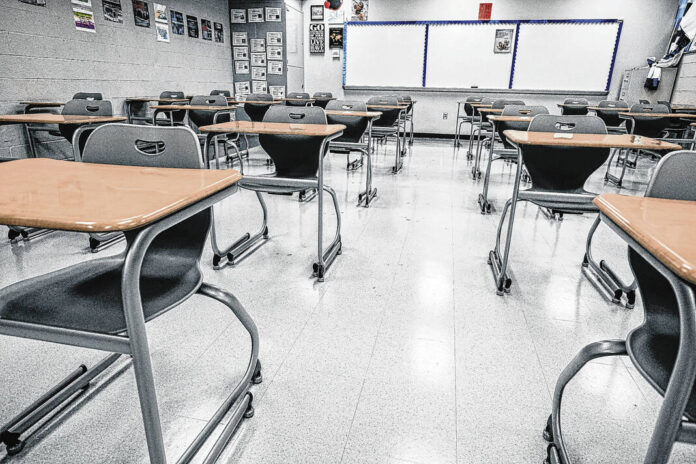
Mike Wolanin | The Republic Desks are shown in Katy Hubbard’s classroom at Columbus North High School in Columbus, Ind., Tuesday, July 28, 2020.
Mike Wolanin | The Republic Desks are shown in Katy Hubbard’s classroom at Columbus North High School in Columbus, Ind., Tuesday, July 28, 2020.
More of Indiana’s elementary and middle school students achieved proficiency in English and math during this year’s ILEARN exams than in 2021, but state officials say it could still take some time for scores to rebound from the pandemic.
Overall, 41.2% of Indiana’s third through eighth grade students were proficient — at or above proficiency standards — in English. Officials said 39.4% were proficient in math, and 30.2% were proficient in both subjects.
This is up from 2021’s results, which were 40.5% for English, 36.9% in math and 28.6% in both categories. However, it is still noticeably lower than the pre-pandemic scores. In 2019, about 48% of students were proficient in English, and a similar percentage for math, while 37.1% of students were proficient in both areas.
However, 2019 data is “not comparable” to 2021 because the earlier year only reflected students who were enrolled for at least 162 days, state officials said.
ILEARN tests proficiency in content standards for English and math in grades three through eight, science in grades four and six, social studies in grade five, biology in middle and high school, and U.S. government in high school.
The test was previously administered in 2019 and 2021. It was not given in 2020 due to COVID-19 related school closures and a federal waiver.
Charity Flores, Indiana Department of Education chief academic officer, said while some student populations’ scores are on their way to pre-pandemic levels, it’s estimated to be three to five years before those scores could surpass 2019’s.
At a local level, English and math proficiency rates from ILEARN show some growth from last year but are still below pre-pandemic results.
Within the Bartholomew Consolidated School Corp., 41.7% of students were proficient in English, 40.2% were proficient in math, and 31.3% were proficient in both subjects.
In 2021, 42.2% of BCSC students were proficient in English, 38.4% in math and 30.8% in both. For 2019, the number of students proficient in English was a little over 50%, and the same was true of math. 40.7% of students were proficient in both.
For the Flat Rock-Hawcreek School Corp. in 2022, 42% of students were proficient in English, 47.7% in math, and 32.8% in both subjects. This is a noticeable uptick from last year’s math results, though the percentage is still down from pre-COVID.
In 2021, 35.9% of Flat Rock-Hawcreek students were proficient in English, 41.7% in math and 25.6% in both subjects.
In 2019, 45.2% of students were proficient in English, 57.1% in math and 40.5% in both.
BCSC test scores
BCSC Superintendent Jim Roberts said that it’s difficult to compare results over the years, given the impact of the pandemic and how the ILEARN assessment continues to evolve.
Still, he said he’s glad the school corporation is “showing progress” and noted proficiency rates in English and math are above the statewide average.
Roberts agreed it might take three to five years for schools to rebound from the pandemic. He said that while 2021-22 was “more typical” in terms of instruction than the previous year, it was still disrupted by COVID-19, with positive cases and close contacts missing school to isolate. The pandemic also interrupted how certain programs such as Book Buddies — which seeks to improve reading skills for second and third graders — were conducted.
“We believed that our scores would reflect, still, the difficulties of COVID-19, and they did,” he said. “Again, that they’re not where they were prior. It’s going to take a bit for us to get them there, and there are a lot of things that we’re going to have to do.”
He said that one of the ways BCSC has sought to improve is by adding more teachers, especially for younger grades. He said this may be why fourth grade was “relatively strong” this year, which was also true at the state level. Sixth and seventh grade also performed well.
Early grades performed “surprisingly well” compared to middle schools, said director of secondary instruction Bill Jensen.
“Once we get into middle school, we had a lot more students quarantined over their years, especially their fifth and sixth grade years, and even then, last year,” he said. “A lot more students quarantined at secondary, because you’re exposed to more students at the secondary level. … They might have missed several chunks of their learning journey.”
He added that he was pleased by seventh graders’ performance, given the significant disruption to their fifth and sixth grade years. Eighth graders saw interruptions to their sixth and seventh grade years, and he expects there to be continuing “ripples” from that disruption.
Roberts said that professional development days are “critical” when it comes to examining the information — not just from ILEARN, but other student performance data as well.
The will “continue to strengthen” its Universal Design for Learning framework to meet all students’ needs and emphasized the importance of focusing on individual students — as well certain student groups, he said.
“There continue to be gaps between certain demographics of students, and we have to understand those gaps and make improvements in that,” said Roberts. “Our strategic plan cites equitable access for all, and we know as a school corporation there are opportunities from Pre-K to senior year where that equitable access has to improve access to opportunity — and through that access to opportunity, students will do better.”
Within BCSC, about 54% of students listed as “paid meals” by the Department of Education were proficient in English, and the same was true of math. On the other hand, 26% of students who qualified for free/reduced meals were proficient in English, and 22.8% were proficient in math. Only 15% were proficient in both subjects, compared to 44% of students on paid meals.
There is also a sizable divide between English Language Learners and other BCSC students, with 20% of ELL students reaching proficiency in English compared to 44.8% of non-ELL students. However, this is an improvement from last year’s result, which was 14.4% of ELL students.
Flat Rock-Hawcreek scores
For Flat Rock-Hawcreek, Superintendent Shawn Price said he is pleased with overall results and is beginning to see more clearly how this data can be used to shape instruction.
He attributed the improved rates to “a consistent approach across all grade levels.”
“I think our teachers do a great job of looking at individual needs of students,” said Price. “And I think really what ILEARN has started to do for us is — it’s always difficult with standardized testing, because we feel like there is a little bit of a moving target there. … It’s not always easy, but when we look across grade levels and start looking at cohort groups, I think the teachers do a really nice job, with administrators leading the way, looking at data and informing instruction that way.”
Price noted that one area for improvement would be elementary students’ writing skills. The school corporation is also keeping an eye on junior high students, who are going through a transitional period in their lives that would be difficult enough without the pressures of the pandemic mixed in.
When asked about how long it might take to recover from the pandemic’s affects on academics, he replied, “That’s definitely unknown. … It’s going to take a number of years. I don’t know that we fully understand the impact of the pandemic and what it’s had on children yet.”
Addressing mental health
Price added that there’s more to the question than just academic standards; it’s also a matter of social and emotional wellbeing.
Roberts expressed a similar sentiment.
“It’s going to take time (to recover),” he said. “We had students lose a lot of classroom instructional time. And not only classroom instructional time; their lives were just completely disrupted. Their families’ lives were completely disrupted.”
Mental health continues to be an important, he said, and it’s difficult to know “how long it will take to help in that area.” He added that BCSC recently appointed Kristin Beck director of wellness for the school corp. While her work will focus mental health, Roberts also expects it to have academic benefits.
According to Jensen, BCSC saw 637 mental health referrals during the 2021-22 school year, compared to 437 in 2020-21 — an increase of almost 46%.
“Primarily, those are at the sixth grade through 12th grade levels,” he said. “So we know when students are dealing with anxiety, depression, coping skill issues — which were the three highest referral reasons — that’s going to impact their test scores. It can’t help but do that.”
Roberts stated that continuing to develop developmental assets and relationships is “critical to moving our students forward.”
“There are just so many variables involved to the academic success of a child and understanding that whole child and addressing those is what we have to do,” he said. “And each child is different. So we will design some things that are corporation-wide or building-wide. … But at the end of the day — I said this at the very beginning — we have to understand that individual child and how we can help him or her based upon that child’s circumstances.”




